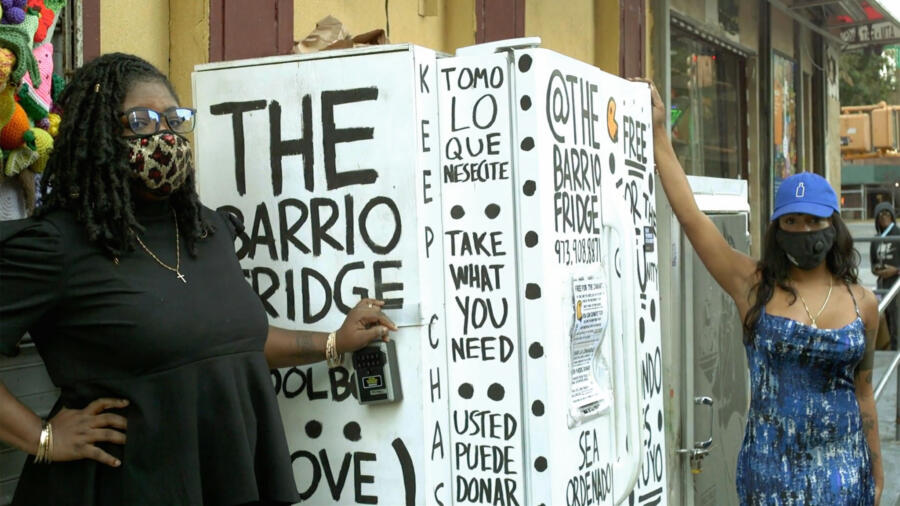According to data compiled by the Food Bank for New York City, nearly 1.1 million New York City residents—or 12.9 percent of the population—are food insecure, meaning they lack access to adequate food because of money or other resources. Shortly after the COVID-19 pandemic hit, childhood friends Seantell Campbell and Darrielle Carter set about changing that in their native East Harlem neighborhood.
In June 2020, Campbell and Carter launched The Barrio Fridge on 108th Street and First Avenue. Open 24 hours a day, seven days a week, is an actual refrigerator on the sidewalk stocked with fresh fruits, vegetables, non-perishable goods and prepared meals donated from all over, for anyone who needs them. People can simply take what they need and leave what they don’t.
Together, the two women and a network of volunteers help ensure the fridge is stocked and clean. Campbell oversees more of the on-the-ground operations and upkeep; Carter handles logistics and communication—including teaching herself to code and launching The Barrio Fridge app, which tracks cleaning and deliveries. They’ve even begun collaborating with local artists to regularly transform the outside of the fridge, turning it into not just a food resource but a piece of public art.
Campbell and Carter discuss growing up in East Harlem, their own experiences with lacking access to enough healthy food and why they wanted to give back to their community through mutual aid.
What makes East Harlem special? What makes it challenging?
Carter: East Harlem has all of these different cultures kind of pushed together, living on top of each other. It’s so tight and it’s such a melting pot.
Campbell: Growing up here, you have to be a little tough. Every day you go to school, but when you come out of school, you’re hit with the real world. Most of our parents were at work. So as a kid, you were on your own from like 3:30 p.m. until about 8 o’clock. Me and my friends built a community and we learned as we went along.
Carter: One of the neighborhood’s challenges is that there’s a serious lack of access to healthy food.
What is your firsthand experience with food insecurity (lacking consistent access to enough healthy food)?
Campbell: I never personally had to face food insecurity. I always had an abundance of food in my house. But at a young age, when I would visit other people’s homes, I realized that there was a difference between the amount of food I had in my home and the amount of food other people had in theirs.
Carter: I lived with my grandmother, my parents and my two brothers, so food didn’t stay in my house very long. Both of my parents were employed, but we didn’t have much access to healthy foods. I remember standing on line with my grandmother at the food pantry to get canned goods and shelf-stable cheese. I think that’s when I realized that we don’t have all the food we needed.
What made you want to start a community fridge?
Campbell: One of the main reasons was because COVID had hit the neighborhood. We’re in a community that already has limited access to healthy foods and resources, and now people were probably going to be laid off and money was going to be tight. There was going to have to be a choice between getting healthy food or getting food that was just going to last longer. So I wanted to alleviate the stress of trying to acquire things like fruits and vegetables.
Carter: We also want to give our community more than just food. It’s also about giving people knowledge. Access to healthy food is not a privilege, it’s a human right.
How has the community embraced the fridge?
Carter: Originally I’m not sure that they were receptive to it. People would walk by and they were intrigued, but confused. I think there was some form of fear that either it would be overrun with rodents or the community just wouldn’t know how to take care of it.
Campbell: I knew that it was a new concept. But I knew that once everyone overcame their doubt and hesitance, everybody was going to love it and it was going to be a pretty big deal in the neighborhood. Because everybody loves free food.
Carter: What’s made me the happiest is seeing the community band together and seeing the outpouring of love from people in the neighborhood. Now people are like, ‘We’ll respect this. We’ll look out for it. We’ll take care of it.’ And that’s our goal: to have the community take care of the fridge.
Watch: Darrielle Carter on Creating Apps to Help Communities
Watch: Seantell Campbell on Creating Access to Fresh Produce
